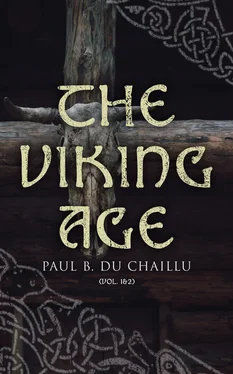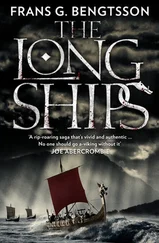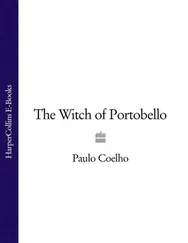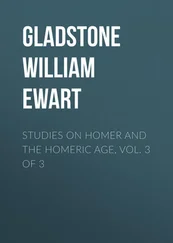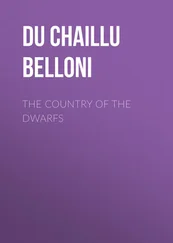“Dag, son of Högni, made a sacrifice to Odin, to avenge his father (who was slain by Helgi); Odin lent his spear to him. Dag met his brother-in-law Helgi at the place called Fjoturlund, he pierced him with the spear, and Helgi fell there” (Helga kvida Hundingsbana II). 226
“In Sweden it was an old custom, from heathen times, that the chief sacrifice (höfudblót) should be at Uppsalir in the month of Goi, and that the sacrifice should be for peace and victory for the King, and men should come thither from all over the Swedish realm” (St. Olaf, c. 76, Heimskringla).
When Hakon jarl returned from Denmark, he ravaged both shores.
“When he had sailed eastward as far as the Gauta Skerries (rocky islets), he went ashore and made a great sacrifice. Two ravens, which croaked loudly, flew towards him, and the jarl thought that Odin must have accepted the sacrifice and that he would have a good chance of victory. He thereupon set fire to his ships and burned them all, and went into the country with his men with warlike intentions” (Fornmanna Sögur, vol. i.).
Sacrifices. —The superintendents of the sacrifices as we have seen were in the earliest times in the North the Hofgodi ( temple priests ), who were called Diar and Drotnar, and were held in great esteem and veneration by the people; but in later times temporal rulers were also priests, and had charge of the sacrifices. 227
“All over Sweden men paid taxes to Odin; one penning (piece of money) for every nose; and he had to defend their land against war; and sacrifice for a good year” (Ynglinga Saga, c. 8).
The animals for sacrifice, which were generally oxen, horses, sheep, boars, and falcons, fattened in order to be of large size and fine appearance, were slaughtered by the temple priest, and in later times, as a rule, in front of the idols. 228Sometimes the superintendence of the sacrificing feast alternated between a certain number of the foremost bœndr 229of the fylki. 230
“It happened in Sweden that the bull which was to be sacrificed was old and so well fed that it was vicious; when men wanted to capture it it ran into the woods and became furious” (Ynglinga, ch. 30).
The people believed that good or bad years were often caused by faith, or want of faith, in the Asa creed; a year was good when their chiefs sacrificed much, bad when they were not zealous sacrificers. 231
The ceremony was divided into two parts: first the slaughtering of animals, and reddening of the temple and altars with blood—probably on the first night; then the sacrificial feast.
In some places the expenses 232of these feasts were defrayed by the godi, who in return had the care of the temple possessions and of the temple tolls: 233in the earliest times people had to pay taxes—a custom said to have been instituted by Odin.
It was the custom to cook the flesh of the slaughtered animals in large kettles hanging over these fires along the floor of the temple. The people then assembled to eat it seated along the walls, and the filled horns were carried between or round the fires, which were probably regarded as holy, the person having charge of the feast consecrating the horns and the meat ( i.e. , making the sign of the hammer of Thor over them). First was drunk the horn of Odin, for victory and power; then Thor’s horn by those who trusted in their own strength and power; Njörd’s and Frey’s horn for good years and peace; Bragi’s when solemn vows were made; and the memorial toast for dead kinsmen which was proposed by the sacrificing priest. 234
Of the solemn ceremonies which took place at the slaying of the living animals we have no description, but the blood from the sacrifices of either animals or human beings was collected into a bowl ( Hlaut-bolli ), generally of copper, which had its place in the temple at the principal altar. The altars and walls of the temple, and the people and idols, were spattered with blood with a kind of broom called Hlaut-tein (blood-twigs).
“Sigurd Hlada-jarl was a very great sacrificer, as his father Hakon had been; he kept up all the sacrificing-feasts in Thrandheim on the king’s behalf. It was an old custom when a sacrifice was to take place that all the bœndr should come to the temple, and take with them the provisions needed while the feast lasted. Every man was to bring ale; there were also slaughtered all kinds of small cattle, as well as horses. All the blood which came therefrom was called hlaut (sacrifice blood), the vessels for holding it hlaut-bowls , and the twigs, hlaut-twigs . With them the altars had to be reddened all over, and also the walls of the temple inside and outside; then the men were to be sprinkled with them, but the flesh had to be boiled for people to eat.
“Fires were to burn on the middle of the temple floor, and kettles to be put on them; the drinking-horns had to be carried around the fire. The chief who made the feast had to consecrate the horns, and all the sacrifice-food. The horn (toast) of Odin must be drunk first, for the victory and power of their king; and then the horn of Njörd and Frey, for a good year and peace. Many used to drink Bragi’s horn next to these. Men also drank horns for those of their kinsmen who had been great men; these were called minni (memorial horns). Sigurd jarl was a most open-handed man; he did a very famous deed, as he held a great sacrificing feast at Hladir, and himself alone paid all the costs” (Hakon Adalsteinsfostri (Hkr.), ch. 16).
It was customary to try and find out the decrees of fate or the will of the gods by a kind of divination or casting of lots with chips dipped in the blood of sacrifices; the most common way of making inquiry was by Blótspán (sacrifice chip) and by lots ( hlut )—both methods of casting lots, but differently performed—the former of which apparently meant the throwing these sacred chips of wood.
Mention is made of the use of scales with lots in them, on one side favourable, on the other side unfavourable; if the favourable one went higher up than the other, it was a good omen.
Einar, an Icelander, and one of Hakon jarl’s scalds, wanted to leave him and join Sigvaldi his foe at the battle of the Jomsviking, for he thought he had not as much honour with the jarl as formerly.
“When Hakon saw that he was going, he shouted for him to come and speak with him, and so he did; the jarl took two scales of burnished silver, gilt all over; with them were two weights, one of gold, the other of silver, on each of which a likeness was made; they were called lots and were of the kind customary with men. Strong qualities were in them, and the jarl used them for all things of importance to him. He used to put them on the scales and tell what each of them should signify to him. When it went well, and the one he wanted came up, the lot in the scale which signified what he wanted never kept quiet, but moved on the scale and made a tinkling sound. These costly things he gave to Einar, who became merry and glad, and desisted from going to Sigvald. From this he got a name and was afterwards called Skálaglam = ‘scale tinkle’ ” (Jomsviking Saga).
“Ingjald gathered men and went against Granmar and his son-in-law, Hjörvard; he had a far larger host than the two others. The battle was hard, and after a short time the chiefs of Fjadrundaland, Vestr-Gautland, Nœriki, and Attundaland (they were with Ingjald), and all the host from these lands, fled. Ingjald received many wounds, and with difficulty escaped to his ships; his foster-father Svipdag the Blind fell there, with both his sons, Gautvid and Hulvid. Ingjald went back to Uppsalir dissatisfied with the expedition; he saw that the hosts from the kingdoms he had conquered were unfaithful. After this there was a great war between the kings; but when it had lasted some time the friends of both brought about a reconciliation. The kings appointed a meeting, met, and all three made peace, which was to stand while they lived; this was bound with oaths and pledges. The next spring Granmar went to Uppsalir to sacrifice for peace, as was the custom towards summer. The sacrifice-chip fell so as to show that he would not live long” (Ynglinga Saga, c. 42).
Читать дальше
